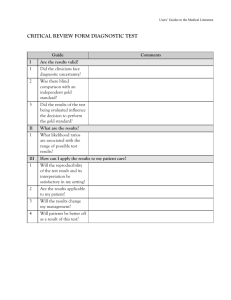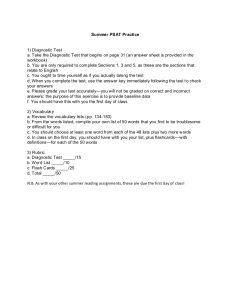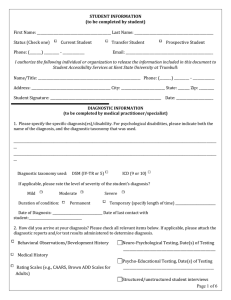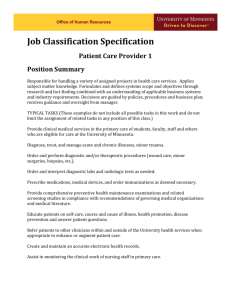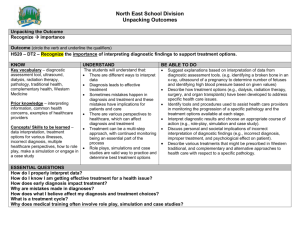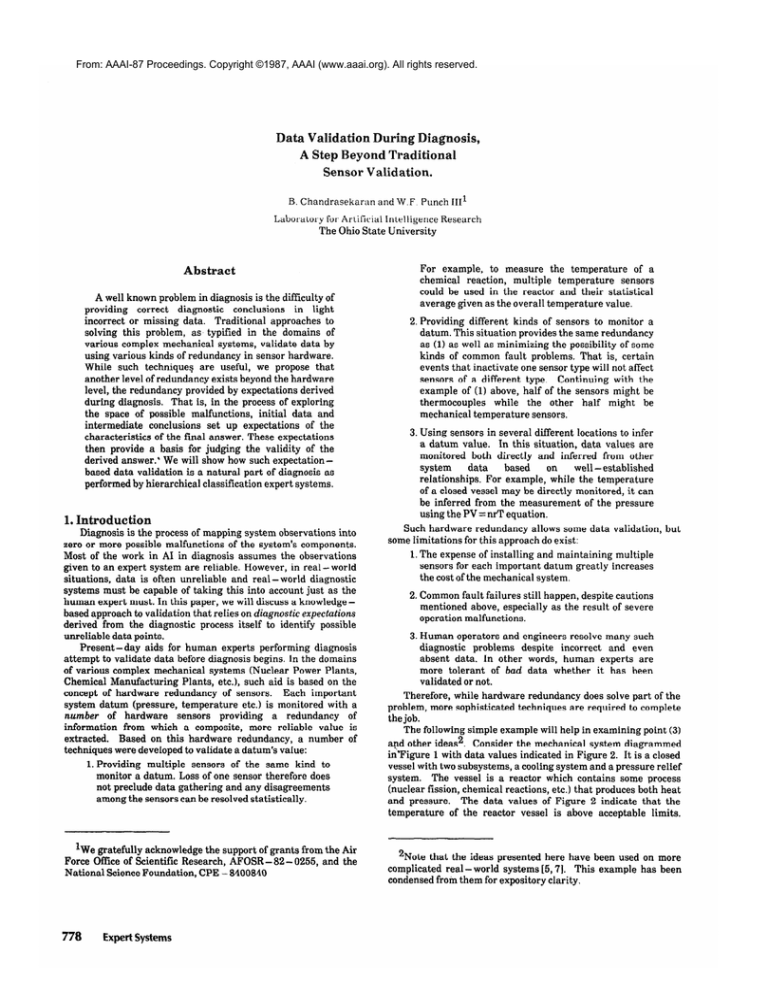
From: AAAI-87 Proceedings. Copyright ©1987, AAAI (www.aaai.org). All rights reserved.
Data Validation
During Diagnosis,
A Step Beyond Traditional
Sensor Validation.
B. Chandrasekaran
Laboratory
Abstract
A well known problem in diagnosis is the difficulty of
providing correct diagnostic
conclusions
in light
incorrect or missing data. Traditional approaches to
solving this problem, as typified in the domains of
various complex mechanical systems, validate data by
using various kinds of redundancy in sensor hardware.
While such techniques are useful, we propose that
another level of redundancy exists beyond the hardware
level, the redundancy provided by expectations derived
during diagnosis. That is, in the process of exploring
the space of possible malfunctions, initial data and
intermediate conclusions set up expectations of the
characteristics of the final answer. These expectations
then provide a basis for judging the validity of the
derived answer.’ We will show how such expectationbased data validation is a natural part of diagnosis as
performed by hierarchical classification expert systems.
1. Introduction
Diagnosis is the process of mapping system observations into
zero or more possible malfunctions of the system’s components.
Most of the work in AI in diagnosis assumes the observations
given to an expert system are reliable. However, in real-world
situations, data is often unreliable and real- world diagnostic
systems must be capable of taking this into account just as the
human expert must. In this paper, we will discuss a knowledge based approach to validation that relies on diagnostic expectations
derived from the diagnostic process itself to identify possible
unreliable data points.
Present -day aids for human experts performing diagnosis
attempt to validate data before diagnosis begins. In the domains
of various complex mechanical systems (Nuclear Power Plants,
Chemical Manufacturing Plants, etc.), such aid is based on the
concept of hardware redundancy of sensors.
Each important
system datum (pressure, temperature etc.) is monitored with a
number of hardware sensors providing a redundancy of
information from which a composite, more reliable value is
extracted. Based on this hardware redundancy, a number of
techniques were developed to validate a datum’s value:
1. Providing multiple sensors of the same kind to
monitor a datum. Loss of one sensor therefore does
not preclude data gathering and any disagreements
among the sensors can be resolved statistically.
IWe gratefully acknowledge the support of grants from the Air
Force Cffice of Scientific Research, AFOSR - 82 - 0255, and the
National Science Foundation, CPE - 8400840
778
Expert Systems
and W.F
Punch III’
for Artificial Intelligence
Research
The Ohio State University
For example, to measure the temperature of a
chemical reaction, multiple temperature sensors
could be used in the reactor and their statistical
average given as the overall temperature value.
2. Providing different kinds of sensors to monitor a
datum. This situation provides the same redundancy
as (1) as well as minimizing the possibility of some
kinds of common fault problems, That is, certain
events that inactivate one sensor type will not affect
sensors of a different type. Continuing with the
example of (1) above, half of the sensors might be
thermocouples
while the other half might be
mechanical temperature sensors.
3. Using sensors in several different locations to infer
a datum value. In this situation, data values are
monitored both directly and inferred from other
system
well -established
data
based
on
relationships. For example, while the temperature
of a closed vessel may be directly monitored, it can
be inferred from the measurement of the pressure
using the PV = nrT equation.
Such hardware redundancy allows some data validation, but
some limitations for this approach do exist:
1. The expense of installing and maintaining multiple
sensors for each important datum greatly increases
the cost of the mechanical system.
2. Common fault failures still happen, despite cautions
mentioned above, especially as the result of severe
operation malfunctions.
3. Human operators and engineers resolve many such
diagnostic problems despite incorrect and even
absent data. In other words, human experts are
more tolerant of bad data whether it has been
validated or not.
Therefore, while hardware redundancy does solve part of the
problem, more sophisticated techniques are required to complete
the job.
The following simple example will help in examining point (3)
and other ideasa. Consider the mechanical system diagrammed
inFigure 1 with data values indicated in Figure 2. It is a closed
vessel with two subsystems, a cooling system and a pressure relief
system. The vessel is a reactor which contains some process
(nuclear fission, chemical reactions, etc.) that produces both heat
and pressure.
The data values of Figure 2 indicate that the
temperature of the reactor vessel is above acceptable limits.
2Note that the ideas presented here have been used on more
complicated real - world systems [5,71. This example has been
condensed from them for expository clarity.
Assume for the example that two possible causes of the high
reactor temperature exist: either the cooling system has failed or
the pressure relief system has failed and the added heat has
overpowered the functioning cooling system. Given the sensor
readings, what would be the diagnostic
conclusion?
The data
conflict is the normal pressure and cooling system readings and
the abnormal pressure relief system readinq:s The failure of the
pressure relief system is plausible, data indicates its failure and
no other system failure, but such a failure expects the pressure to
be high! The step to take is to assume that both the pressure relief
system failed and the pressure sensor is incorrect.
The process shown above demonstrates data validation at a
higher level than that of simple sensor hardware validation. In
the example, the pressure system has failed despite the lack of a
high pressure datum. However, there is other strong evidence3
that the pressure system has indeed failed. The human reasoner
expects the pressure datum to be high since the preponderance of
other data indicate a malfunction. That is, the human reasoner in
pursuing likely diagnostic conclusions discovers a plausible
diagnostic conclusion that meets all but (in this case) one
expectation. The important points to note are that:
1. A diagnostic conclusion can and should be made
based on the preponderance of other evidence.
2. The datum value that does not meet expectation
should be questioned and further investigation of its
true value made.
Note that this process involves redundancy, not at the level of
sensor hardware, but at the level of diagnostic expectation. This is
a redundancy of information that allows questioning (and
subsequent validation) of data based on multiple expectations of
diagnostic conclusions. If a conclusion is likely, but not all of its
expectations are met, then those now questionable values are
investigated by more computationally expensive techniques.
Such expectations can be the result of one of a number of
processes. Deep models can provide information on expected data
patterns for any diagnostic conclusion. From this information,
judgments on the reliability of any of the actual data values can
be made. Information provided from such deep models can he
incorporated into compiled structures that can also provide
information on data reliability. Finally, the expert himself can
provide the information on data reliability to the diagnosis
system based on his expert judgment of the particular diagnostic
process, in effect acting as the deep model for the system.
Figure 1: An Example Mechanical System
In this paper we will discuss compiled diagnostic systems that
deal with conflicting datum at the level of diagnostic expectation
indicated above. These are diagnostic systems that make
conclusions based on diagnostic knowledge and some judgment on
the validity of the data provided. In particular, we will show how
31n the example, this evidence is that there is a failure of the
relief valve system which is part of the pressure system.
Variable
Status
Temperature
High
Pressure
Normal
Condenser
All sensors
Normal
Cooling Water
Flow System
All Sensors
Normal
Relief Valve
Sensors indicate
Malfunction
Valve Control
System
All sensors
Normal
Figure 2: Sensor Values for the Example
redundancy of diagnostic expectation is a natural extension
hierarchical classification diagnostic model.
2. Diagnosis
as a Hierarchical
to the
CBassification Task
Significant interest has recently been directed towards
understanding problem solving behaviors (diagnosis, planning,
design) from the viewpoint of Information Processing Strategies.
For example, Clancey 141 has shown that MYCIN is a species of
classification problem solving activity. Earlier, in our work on
MDX [2], we explicitly identified hierarchical classification as a
strategy useful for some classes of diagnostic problem solving.
Diagnosis as a classification problem solving task is a
matching of the data of the problem against a set of malfunctions
(i.e., diseases, system failures, etch. If the present data are
classified as a known malfunction, then the diagnosis is
completed. Note that this is a compiled approach to diagnosis
since it requires that the possible malfunctions and knowledge
about how to establish those malfunctions be pre-enumerated.
Other less well defined problems require a deeper model that rely
on first principles (physics, chemistry, etc.) and an intimate
understanding of the system at hand4. The rest of this section
discusses the basic ideas behind hierarchical classification (See
[6,2] for details).
The malfunctions (diseases, failures) possible in the system
are organized hierarchically. Typically, this hierarchy reflects a
or function:sub - function
systemsub - system
relationship
between the malfunctions?. Continuing with the example system
in Figure 1, the malfunction hierarchy for the reactor system is
shown in Figure 3. Each node in the malfunction hierarchy
represents the hypothesis that some particular malfunction has
occurred. Note that the nodes located in the upper levels of the
hierarchy (Pressure System Failure, Cooling System Failure)
represent more abstract malfunction hypotheses then those lower
in the hierarchy (Relief Valve Failure, Condenser Failure).
Further note that the sub nodes of any node are more particular
kinds of the super node. For example, a Relief Value Failure is a
particular kind of Pressure System Failure. Therefore, as one
traverses the hierarchy in a top down fashion, one examines more
detailed hypotheses about what malfunction has occurred in the
system.
4Space limits this paper to the compiled system issues, see
reference [91 for a detailed discussion of the deep model issues and
computational strategies.
5Though the simple examples of this paper use only a single
hierarchy, other work [lOI recognizes that multiple hierarchies
may be required to properly represent all system malfunctions.
Chandrasekaran and Bunch
779
Each node in the hierarchy has knowledge about the
conditions under which the malfunction hypothesis it represents
is plausible. Each node of the malfunction hierarchy is therefore
a small expert system that evaluates whether the malfunction
hypothesis it represents is present given the data. While there
are a number of ways this could be accomplished, conceptually
what is required
is patternmatching
based on data features
Each node contains a set of features that are compared against
the data. The results of this comparison indicate the likelihood of
that particular
alfunction being present. The pattern matching
structure of a n r de in the CSRL language [l] is called a knowledge
group. The knowledge groups compare relevant features against
the data and yield a symbolic likelihood.
) Is theTemperature
Alarm on?
) What is theTemperature
above the Condenser
of the Cooling Water Out?
3 ) What is the Temperature
Figure 4: A Knowledge Group from Cooling System Failure
System
Failure
Pressure
System
Failllre
r-
I:
continues until there are no more nodes to examine. In this way,
the most specific malfunctions that can be confirmed are given as
the diagnostic conclusion8.
Cooling System
FailIN-e
3. Data Validation
Relief Valve
FflilUl-e
Valve Control
Failure
Condenser
Failure
Feed System
FailUl-2
Figure 3: Hierarchy of malfunctions from Figure 1
Consider the knowledge group depicted in Figure 4 taken from
the Cooling System Failure node of our example. The first, section
represents three queries about a datum value6. Each column of
the table underneath represents a possible answer to each
question (column 1 to question 1, etc.). The match value assigned
to the knowledge group is based on the value located at the end of
each row7. In our example when the answer to question 1 is True,
the answer to question 2 is either High or Low and regardless of
the answer to question 3, row 1 assigns a value of 3 to the
knowledge group. The rows of the table are evaluated in order
until either a row of queries matches or no row matches and a
default value is assigned. Thus, when the data pattern of row 1
exists, the knowledge group (and thus the malfunction) is
established at a high level of confidence.
Finally, the control strategy of a hierarchical classifier is
termed establish-refine.
In this strategy, each node is asked to
establish how likely the malfunction hypothesis it represents is
given the data. The node, using knowledge groups, determines an
overall measure of likelihood. If the node establishes, i.e,. the
malfunction is judged likely, then each sub of that node are asked
to try and establish themselves. If a node is found to be unlikely,
then that node is ruled-out and none its subs are evaluated.
Consider the example using the data from Figure 2 and the
hierarchy of Figure 3. The top node is established since the
temperature is high. Each of the subnodes is then asked to
establish. Cooling System Failure rules out and none of its
subnodes are examined. Pressure Relief Failure establishes and
its subs are asked to try and establish themselves. This process
%n the present CSRL implementation, these values are fetched
from a database, though other means may be used, such as calls to
deep models, simulations, etc.
71n this case, the values assigned are on a discrete scale from
-3
to 3, - 3 representing ruled- out and 3 representing
confirmed.
780
Expert Systems
Two important methods are available for validating data in
conjunction with hierarchical classification. First, it is possible
to establish a malfunction based on a preponderance of other
evidence. If the node can establish but not all the data it expects
is present., the data not meeting expectation is subject to question.
In the original example, the Pressure Relief System Failure
established despite a normal pressure reading based on a
preponderance or other evidence.
Secondly, intermediate diagnostic conclusions from other
nodes provide a context to evaluate data. If the Pressure System
Failure does establish, its subs can expect the pressure reading to
be abnormal. If it is not, they can also question the pressure
reading.
In the remainder of this section, we will discuss the following
aspects of a data validation system:
1. How data is
expectations.
questioned
based
on
2. The various methodologies available
resolve the questionable data.
diagnostic
that could
3. How the normal control flow of diagnostic probiem
solving is affected.
Discovering a questionable datum involves two steps. First,
set some expectations, using local knowledge or the context of
Second, use those expectations to flag some
other nodes.
particular data value as questionable.
The expectations of a malfunction are embodied in the
knowledge group. The knowledge group mechanism was designed
to give a rating of pattern fit to data. If the fit is not as expected,
those data values not meeting expectations are identified as
questionable. In the example of Pressure Relief Valve Failure,
evidence exists that the valve has failed even though the pressure
is normal. The lack of fit between data and pattern allow the
pressure value to be identified as questionable.
Diagnosis
continues despite apparent data conflict since enough evidence
exists for establishing the malfunction hypothesis.
8Note that if multiple conclusions are reached, then either
multiple independent malfunctions have occurred or multiple
dependent malfunctions must be resolved into a smaller set [81.
Furthermore, the expectations of previous nodes create a
context of expectation for the node currently being examined.
Consider the example hierarchy of Figure 3. In order to establish
the malfunction
hypothesis Relief Value Failure, the malfunction
hypothesis Pressure System Failure must have established.
In
the context of considering
the Valve Failure, some expectations
were created based on the establishment
of the Pressure System
Failure
node and other ancestors.
Since these expectations
always exist when considering Valve Failure, i.e., you can’t get to
Valve Failure without establishing Pressure System Failure,
they can be coded into the Valve Failure Node.
How expectations are used for the Pressure Relief System
Failure node is shown in Figure 5. A modification is made to the
standard knowledge group of Figure 4 that allows the expert to
indicate both a match value for the group and a set of data that do
not meet the expectations established at this stage of the problem
solving.
Thus, Pressure Relief Failure establishes (based on
other data features) despite the lack of a change of pressure.
However, in establishing the node, one should question why the
pressure did not change. This is done by placing the pressure
value in the rightmost column of the matching row. If that row is
matched, then the match value is returned but the indicated data
value is placed in a list of questionable data values which will be
examined later. If the match value is high enough, the node
establishes despite the existence of conflicting data. That is, if
there is enough evidence to show a malfunction despite a
conflicting value, the problem solving may continue. However, it
may be the case that the value being questioned is of vital
importance to establishing the node. The match value will reflect
this, the node will not establish, but the data will still be placed on
the questionable data list. After an initial run of the problem
solver, the questionable data list will consist of data values that
did not meet the expectations of some node.
node are subdivided among the knowledge groups that need them.
That is, even within the node, the data is further partitioned to
The
only those knowledge
groups that will use that data.
knowledge engineer is therefore presented
with a much simpler
task. Only those combinations
of a few data items that present ‘1
missed expectation
need be encoded into the diagnostic
system
I) Is the Pressure Alarm on?
2) What is the Pressure
above the Condenser?
3) Is the Temperature
Alarm activated?
Figure 5: Knowledge Group Modified for Data Validation
Exphsion
The knowledge engineer is responsible for providing the node
with both feature matching data and datum values that do not
meet expectations of the malfunction hypothesis at that point.
This, as mentioned previously, is a compiled approach to data
validation. It may appear that such a compilation of possibilities
will result in a combinatorial explosion. However, not all possible
combinations of sensor readings need be encoded; only those
situations which the expert deems reasonable or necessary need
be placed in the knowledge groups. More importantly, in our
approach to use of knowledge groups, a hierarchy of abstractions
is used to go from the data to the classi&atory conclusion C31.
Thus, the set of data elements needed for any node in the
hierarchy is limited to only those relevant for the malfunction
hypothesis it represents. Furthermore, the d&a elements of each
3.4. Control Issues
While sections 3.1 and 3.3 have discussed discovering and
resolving possibly invalid data, this section addresses the issues
of control flow changes to the normal establish - refine strategy.
1. What happens to data whose values have been
proven to be either incorrect or unresolved? If found
to be incorrect, the value in the data base must be
modified, i.e., the central data base value modified,
to indicate the change. If unresolved, it must be
flagged as such in hopes of being resolved later.
2. If incorrect data has been found, then it is possible
that the problem solver made some mistakes in its
diagnosis. It may be necessary to re- run the
hierarchy to see if the diagnostic conclusions
change. Furthermore, any unresolved data may be
resolved as a result of the new information.
3. The basic control strategy would then look like the
following cycle:
Chandrasekaran and Punch
781
a. Run the Hierarchy,
values.
finding
questionable
b. Run resolution techniques of section
resolve the values if possible.
c. Update
3.3 to
the data base with any changes.
This cycle continues
until *either
no
questioned
or the user sees an answer
satisfactory.
data
that
is
to Date
The majority of the structures and strategies indicated in the
paper have been included into a version of the CSRL [l] tool as it
has been applied to diagnosis of Cooling System Accidents in a
Boiling Water Nuclear Power Plant. The knowledge groups have
been modified as indicated in Figure 5 such that a datum value is
questioned whenever it does not meet expectation. A number of
scenarios of data conflict have been encoded into this system
concerning the plant and more are being added. The control
strategies that allow the hierarchy to be re - run until either no
data is questioned or the user is satisfied have been implemented.
Future work will concentrate on problems of backtracking to
prevent re - running the entire hierarchy. With regards to data
value resolution, present work is focusing on methodologies for
resolving’questionable
sensors as indicated in Section 3.3. To
date, each kind of sensor has associated with it a set of hardware
checks that are not normally invoked.
Furthermore, if the
additional hardware checks do not resolve the problem, the user
is presented with the conflict and information on all the nodes
that used that value, including whether that value was
questioned there or not.
5. Conclusion
While some data validation can be done using the standard
techniques of hardware redundancy, a higher level of redundancy
based on diagnostic expectations can address more of the issues of
conflicting data in a more sensible manner.
Intermediate
diagnostic conclusions from hierarchical diagnosticians provide
expectations that can indicate invalid data values. Note that the
method is deceptively simple. This is due to the focus provided by
chunking the match and expectation knowledge into the smaller,
more manageable parts in the knowledge groups. Furthermore,
the hierarchy also acts to simplify the complexity of the match
and expectation knowledge due to the context of information
provided by the establishment or rejection of parent nodes.
Despite this, much power can be gained in both diagnosis and
sensor/data validation by use of these simple methods. Some
advantages include:
1. Questioning data based on diagnostic expectations
provides a way to focus on only some data, as
opposed to hardware methods which must worry
about all data a priori.
2. Even if a data value is questioned, the diagnostic
process can continue if other evidence exists for the
failure. Thus the system can work with conflicting
data.
782
Expert Systems
4. The programming
by a user of such a system is
facilitated
by existing tools (CSRL) that need on11
minor modifications.
is
4. Other control strategies ,are also available. The
resolution techniques of section 3.3 could be run as
soon as a data item is questioned, i.e., right in the
middle of the problem solving. This requires a
backtracking scheme that re - runs any other node
*that used that value. Finally, the operator can be
directly involved in changing data values at any
step of the process based on his/her expert opinion of
the situation.
4. Implementation
3. Such a system integrates well with existing systems
that presently rely solely on hardware redundancy
by using those valbes as data for both diagnosis and
a higher level of data validation.
Acknowledgments
We would like to thank Don Miller, Brian Hajek and Sia
Hashemi of the Division of Nuclear Engineering at the Ohio State
University for their help in developing and implementing these
ideas. Also, one of the authors (Punch) would like to thank Mike
Tanner for his invaluable aid in criticizing this paper and
sharpening its ideas.
References
1. T. C. Bylander /S. Mittal. CSRL: A Language for
Classificatory Problem Solving and Uncertainty Handling. AZ
Magazine ‘/(Summer 1986).
2. B. Chandrasekaran / S. Mittal. Conceptual Representation of
Medical Knowledge for Diagnosis by Computer: MDX and
Related Systems. In Advances in Computers, M. Yovits, Ed.,
Academic Press, 1983, pp. 217 - 293.
3. B. Chandrasekaran. From Numbers to Symbols to Knowledge
Structures: Pattern Recognition and Artificial Intelligence
Perspectives on the Classification Task. In Pattern Recognition
in Practice -ZZ, North Holland Publishing, 1986, pp. 547 - 559.
4. W. J. Clancey. Heuristic Classification.
27,3 (1985),289-350.
Artificial
Intelligence
5. J. F. Davis/W. F. Punch III / S. K. Shum / B. Chandrasekaran.
Application of Knowledge - Base Systems for the Diagnosis of
Operating Problems. Presented to AIChe. Annual Meeting,
Chicago Ill. 1985.
6. Comez, F. / Chandrasekaran, B. Knowledge Organization and
Distribution for Medical Diagnosis. 1EEE Transactions on
Systems, Man, and Cybernetics SMC -11,l (January 19811,
34-42.
7. S. Hashemi, B.K. Hajek, D.W. Miller, B. Chandrasekaran, and
J.R. Josephson. Expert Systems Application to Plant Diagnosis
and Sensor Data Validation. Proc. of the Sixth Power Plant
Dynamics, Control and Testing Symposium, Knoxville,
Tennessee, April, 1986.
8. J. R. Josephson, B. Chandrasekaran and J. W. Smith, M.D.
Abduction by Classification, Assembly, and Criticism. Revision
of an earlier version called * ‘Abduction by Classification and
Assembly” which appears in Proc. Philosophy of Science
Association, Vol.1, Biennial Meeting, 1986. 1986.
9. V. Sembugamoorthy / B. Chandrasekaran. Functional
representation of devices and compilation of diagnostic problem
solving systems. In Experience, Memory and Reasoning,
J. L. Kolodner and C. K. Riesbeck, Eds., Erlbaum, 1986, pp.
47-73.
10. J. Sticklen. MDXB: An Integrated Diagnostic Approach.
Dissertation In Progress, Ohio State University. 1987.

